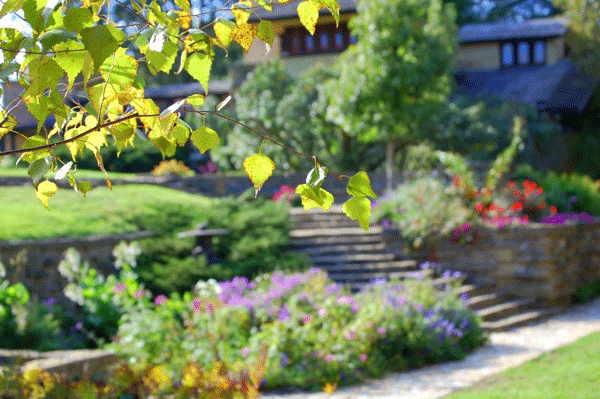 |
|

|
||||||||||
Art-chitecture: Taliesin through the eyes of Frank Lloyd Wright |
||||||||||||||||
| Continued... | ||||||||||||||||
Wright enjoyed taking trips to visit friends and relatives who lived in homes he designed for them. In 1938, he constructed the Wingspread home in Racine for a good friend, Samuel Johnson. Years after its construction, Johnson remarried, and his second wife, Irene, did not relate to the house and its simple and temperate decor. She went to great lengths to redecorate the interior using her own artistic taste. However, when Wright visited the new couple a few years later, he woke himself at four in the morning to redecorate their home in accordance with his initial design. “He took some of the furniture that he didn't think was particularly appropriate and put it in a storeroom. He changed many of the paintings, and then waited for Irene to come down for breakfast,” Johnson wrote. “I don't think she and Mr. Wright ever spoke seriously after that.”
Wright also placed his signature mark on each of his designs, with a ceramic red tile indicating its authenticity. Although the tile symbolizes worth and pride to Wright homeowners today, it did not always come with a guarantee. Wright was known to visit his finished work and inspect its resemblance to his original vision for the site. If the owners were not willing to keep the home precisely as Wright imagined, he would chisel out the tile himself and walk away. However, Wright also believed in doing good for others and was a generous man, albeit a difficult one to live with. A Devoted Mentor There is a story told at the Taliesin site about a young girl who used to come and visit the grounds while one of her parents worked for Wright as a maid. Whenever she was in a room with Wright, she hid behind furniture or a door because his wild beard and towering top hat scared her to tears. Knowing to take small gestures in trying to befriend her, Wright would tease her and tap her on the head with his cane, proving that he could play along with her game. Frank and Olgivanna Lloyd Wright founded the Taliesin Fellowship in 1932 by selecting a handful of apprentices from around the country to live and study at Taliesin. The prestigious program continues to operate today as the Frank Lloyd Wright School of Architecture, under the same philosophy Wright established for his students.
“The fine arts, so called,” he wrote, “should stand at the center as inspiration grouped about architecture.” The education at Taliesin emphasizes painting, sculpture, music, drama and dance in their places as divisions of architecture. While he was alive, Wright took the apprentices under his wing and watched over their work with intense care. He loved to spend time with them, as if they were a part of his family, and he required a daily afternoon gathering in his gardens to drink tea and discuss their projects. During the winter, Wright brought the students into his home and in front of an enormous, crackling fireplace to exchange ideas and listen to music. To him, the hearth was the heart of the home, which inspired him to center the floor plans of each building around a large fireplace. Wright designed more than 1,000 fireplaces throughout his career, each one a unique sculpture revered by owners of the home. Art-chitecture As the late afternoon sun casts its long shadows across the courtyards and terraces at the Taliesin site, Wright’s vision as an artist comes into sharp focus. From the low, elongated wings that form the roofline of the sprawling structure that embraces the hilltop to the gently rolling valleys with their vineyards, orchards and golden corn, this artist’s masterpiece is on display to soothe the mind while stimulating the senses. Taliesin stands as a monument to Wright's artistic sensibilities and his need to work in concert with nature to create structural works of art.
|
||||||||||||||||
About Us | Contact Us | Business Partners | Archives | Sitemap
Copyright 2007 Curb Magazine


